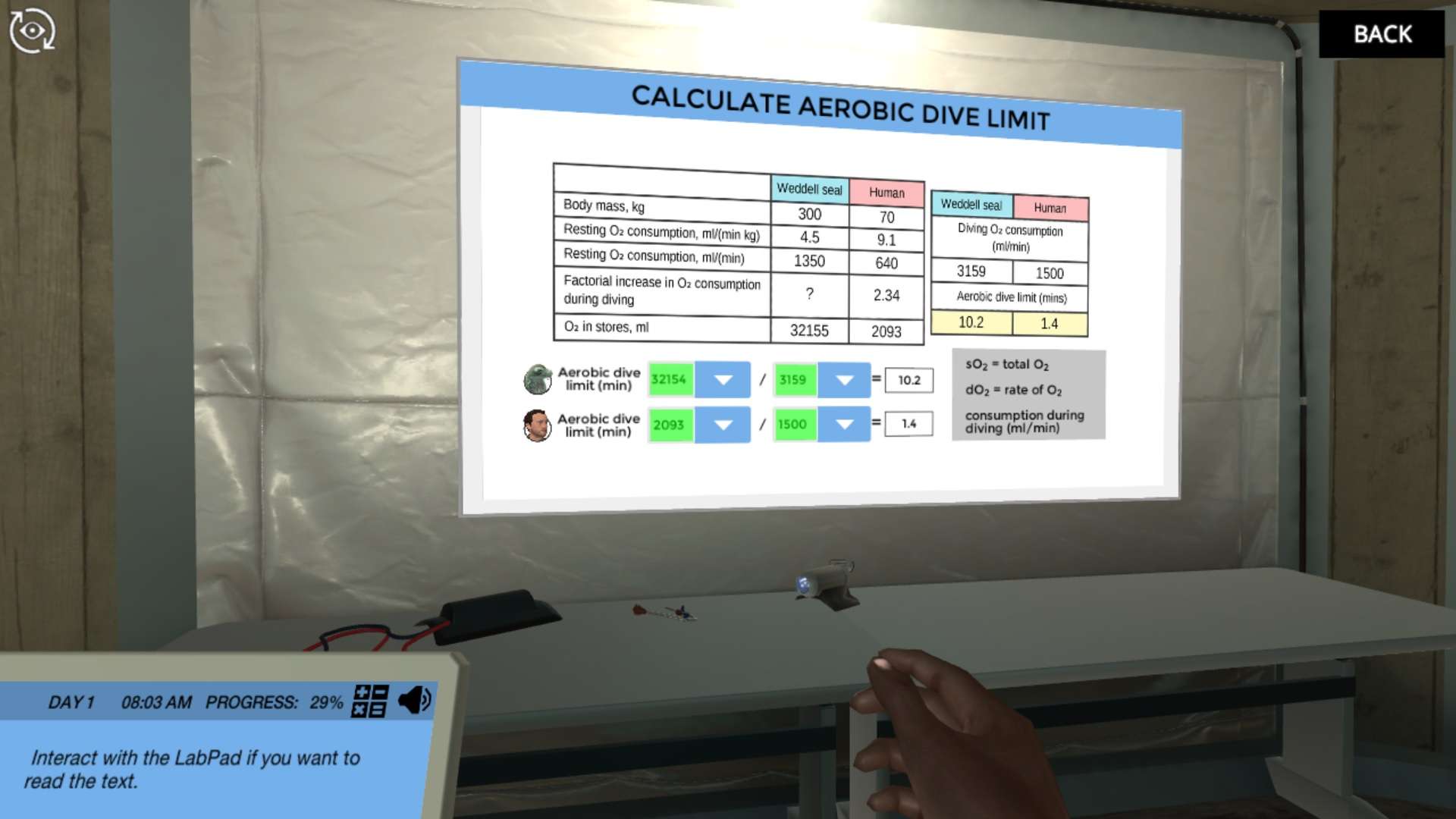Heading 1
Heading 2
Heading 3
Heading 4
Heading 5
Heading 6
Lorem ipsum dolor sit amet, consectetur adipiscing elit, sed do eiusmod tempor incididunt ut labore et dolore magna aliqua. Ut enim ad minim veniam, quis nostrud exercitation ullamco laboris nisi ut aliquip ex ea commodo consequat. Duis aute irure dolor in reprehenderit in voluptate velit esse cillum dolore eu fugiat nulla pariatur.
Block quote
Ordered list
- Item 1
- Item 2
- Item 3
Unordered list
- Item A
- Item B
- Item C
Bold text
Emphasis
Superscript
Subscript
About This Simulation
Monitor three dives of a Weddell seal in Antarctica and discover how long it can dive with the oxygen available in its stores.
Learning Objectives
- Explain physiological adaptations of the cardio-respiratory system of seals to deep diving
- Point out differences between human and seal physiology during long, deep dives without oxygen
- Evaluate respiratory and cardiovascular function
- Measure oxygen consumption and calculate the total amount of oxygen needed for dives of various durations, and compare this to estimated oxygen stores in the lungs, blood, and tissues of seals
- Use graphing approaches to relate type of exercise to metabolic and heart rates
About This Simulation
Lab Techniques
- Use a metabolic dome and oxygen analyzer to collect oxygen consumption data
- Interpret an ECG
- Catheter insertion and blood collection at different time points
- Data analysis through calculations and results interpretation (calculate total oxygen stores, aerobic dive limit, oxygen consumption, and ATP generation from aerobic and partially anaerobic dives)
Related Standards
- No direct alignment
- No direct alignment
- Biology D.6 Transport of respiratory gases
- 6.4 Gas exchange
Learn More About This Simulation
How Weddell seals can dive up to 600 meters and for over 30 minutes is a bit of a mystery. In this simulation, you will learn about oxygen stores, aerobic dive limit, aerobic and partially anaerobic ATP generation, and special cardio-respiratory adaptations that allow seals to perform deep, long dives that would be impossible for humans without scuba diving equipment.
Monitor seal dives in Antarctica
Welcome to the Labster research station in Antarctica! Here, you will join our team and help monitor Weddell seal dives to study what cardio-respiratory adaptations seals possess to be able to dive so deep and for such a long amount of time. Humans and seals have different amounts of oxygen available to them, and they also store it at different proportions in lungs, blood and muscle. Do seals and humans have the same factorial increase in oxygen consumption? Monitor three dives and collect data on consumed oxygen and blood lactate to find out.
Get a puzzle piece for each calculation you get right
You will equip a Weddell seal with a camera, instruments pack and catheter for blood collection, and watch it dive and come back up to the surface of the hole in the ice in the research hut. Through fun mini-games, you will calculate available oxygen, aerobic dive limit and ATPs generated during aerobic and partially anaerobic dives. For each correct result, you will get a piece of the puzzle!
Swim with a seal
At the end, when you have all your puzzle pieces, your reward will be an interactive dive with the seal. You will be able to see a summary of its main cardio-respiratory adaptations to diving.
Will you be able to guess them before you click the different parts?
For Science Programs Providing a Learning Advantage
Boost STEM Pass Rates
Boost Learning with Fun
75% of students show high engagement and improved grades with Labster
Discover Simulations That Match Your Syllabus
Easily bolster your learning objectives with relevant, interactive content
Place Students in the Shoes of Real Scientists
Practice a lab procedure or visualize theory through narrative-driven scenarios


FAQs
Find answers to frequently asked questions.
Heading 1
Heading 2
Heading 3
Heading 4
Heading 5
Heading 6
Lorem ipsum dolor sit amet, consectetur adipiscing elit, sed do eiusmod tempor incididunt ut labore et dolore magna aliqua. Ut enim ad minim veniam, quis nostrud exercitation ullamco laboris nisi ut aliquip ex ea commodo consequat. Duis aute irure dolor in reprehenderit in voluptate velit esse cillum dolore eu fugiat nulla pariatur.
Block quote
Ordered list
- Item 1
- Item 2
- Item 3
Unordered list
- Item A
- Item B
- Item C
Bold text
Emphasis
Superscript
Subscript
A Labster virtual lab is an interactive, multimedia assignment that students access right from their computers. Many Labster virtual labs prepare students for success in college by introducing foundational knowledge using multimedia visualizations that make it easier to understand complex concepts. Other Labster virtual labs prepare learners for careers in STEM labs by giving them realistic practice on lab techniques and procedures.
Labster’s virtual lab simulations are created by scientists and designed to maximize engagement and interactivity. Unlike watching a video or reading a textbook, Labster virtual labs are interactive. To make progress, students must think critically and solve a real-world problem. We believe that learning by doing makes STEM stick.
Yes, Labster is compatible with all major LMS (Learning Management Systems) including Blackboard, Canvas, D2L, Moodle, and many others. Students can access Labster like any other assignment. If your institution does not choose an LMS integration, students will log into Labster’s Course Manager once they have an account created. Your institution will decide which is the best access method.
Labster is available for purchase by instructors, faculty, and administrators at education institutions. Purchasing our starter package, Labster Explorer, can be done using a credit card if you are located in the USA, Canada, or Mexico. If you are outside of North America or are choosing a higher plan, please speak with a Labster sales representative. Compare plans.
Labster supports a wide range of STEM courses at the high school, college, and university level across fields in biology, chemistry, physics, and health sciences. You can identify topics for your courses by searching our Content Catalog.















